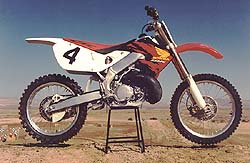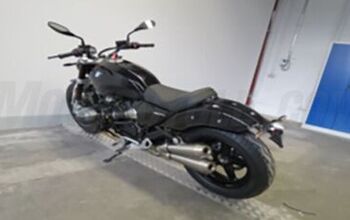First Ride: 1997 Honda CR250R - Motorcycle.com
Every year thousands of off-road riders flock to the news stands to see the latest model releases in the magazines. Every year thousands utter those same words.
They all craved the first bike with inverted forks. After that, strangely enough, they all lusted after the first bike with conventional suspenders.
No matter what the change, the new bike was always better. Or so it seemed. Maybe it was just the bright new wrapper, but they still wanted it.
Honda has come up with one hell of a wrapper for the 1997 CR250R. Who can miss that frame?
Even roadracers, who think that dirt is only for burying people, feel the new CR250 is boss looking. Structurally, the concept is the same -- a more rigid frame allows the suspension to work better and give greater rider feedback.
Well, now Honda has the stiffest of frames in off-road racing. Of course, with bold new design changes comes the big questions. Will it work for all skill levels? Will it survive the tremendous pounding of Supercross? What if I don't race, will this machine work as a play bike? The Honda tech guys say Yes, Yes, and Yes!
According to a Honda spokesman, rumors of frame breakage are not responsible for the late release of the '97 250. The blame is on the suspension components. Not that that's a bad thing, because this time Honda wanted to get the forks and shock to perform in the same manner they knew the frame would. When Honda decided to go ahead with the perimeter frame, they found that the existing valving and damping rates were off the scale of acceptance, and had to basically re-figure all of the rates. Once that was accomplished, the revised specs were sent to Japan.
Did it all pay off? Honda claims they ended up with settings almost every rider can make work, without the need for expensive modifications. They also claim the suspension is more sensitive to adjustment, making it easier to dial it in. The forks come with a 0.4kg/mm spring rate, and the shock a 5.3kg/mm rate. Both have a softer and stiffer option that will be available through local Honda dealers.
The seat, airbox, silencer and sub-frame can all be quickly removed together. With those parts, and the fuel tank gone, servicing the shock or carb is a breeze. Other advantages of the frame design are a lower center of gravity, a four pound weight savings, and room to mount a single large radiator with 150% more cooling efficiency. The '97 CR250R gets a new Keihin Powerjet carb, a map type ignition system to minimize wheel spin by monitoring engine rpm, and a rear brake rotor 20mm larger than last year (it's now the same diameter as the front rotor).
The powerjet carb is sort of confusing in tech talk. Honda's wording is: "The powerjet starts to flow fuel at about 1/4 throttle. This is when the engine has created enough vacuum to pull the fuel up through the powerjet valve and will continue to flow fuel until 8,100 rpm, at which time the powerjet solenoid is turned on closing the powerjet valve." Basically the valve stays open whenever the revs are below 8,100, offering crisper throttle response. Though you would think with the powerjet the motor would use more fuel, Honda states it actually gets slightly better mileage.
The map type ignition monitors wheel spin at something like 28 times per second to modulate the amount of wheel spin to provide maximum traction. After you get all the traction you can, the always potent 250cc Honda motor moves the whole package along quickly. You'll thank the engineers for making the rear brake rotor 20mm larger, easily bringing things to a halt and getting it turned at the end of the straights.
"The stiffness of the chassis gives the bike a solid feel that translates into speed and confidence."
If it isn't broke, don't fix it. Had to have been Honda's motto with the CR's engine, because no major changes were made to one of the best motors ever stuffed into a motocross chassis. For the last couple of years, everybody has raved about the strength and durability of the CR powerplant, and with few changes made along the way, it still remains one of the best. Though many thought the CR was more pro-oriented, the starting line is getting redder (pinker?) in MX classes of all skill levels.
Enough tech talk already, how does the darn thing ride? Honda invited the motorcycling press out to their high-desert test facility last week so everyone could see for themselves. When you climb aboard, the first thing you notice is how slim the seat/tank junction is. The feel and roominess of what is basically a Steve Lamson replica handlebar, invites you to take control and begs you to twist the throttle.
The seat foam is firm enough to allow sliding back and forth with ease without causing great discomfort after a day in the saddle. Fuel petcock and carburetor choke assembly are a little easier to locate with the new generation frame. Levers feel good and operate smoothly, although the grips seemed like they were made of a harder compound.
The engine started with a single kick and our adrenaline started to flow much quicker as the tranny accepted first gear with nothing more than a slight click. At first the CR didn't like to start in gear, but as the day wore on and the clutch broke in, it would light off no matter what gear the bike was in.
A Honda mechanic stated that the bikes were being run on a blend of pump gas and Honda HP2 premix instead of the race gas used for past new model intros. The engine carburated cleanly and throttle response was fairly crisp with what will basically be stock jetting. We experienced no bog or hesitation when the motor was under load.
Under way, the bike allows you to do things right off the bat that you would normally have to work up to doing, like small doubles or a rolling whoop section. The stiffness of the chassis gives the bike a solid feel that translates into speed and confidence. Motor response is great -- typical CR. Power comes on early and plentiful with a strong mid-range grunt, and enough power up top to pull taller gears. And pull it will...for a long time too, with plenty of over-rev. The bike can be screamed out of corners, and it will allow you to run a gear higher later in the moto when you're not as energetic.
"This is one of the easiest motorcycles to ride."
The motor may be standard Honda issue, but bolted into this frame the whole package comes alive. It's not that the '96 CR250 is a bad motorcycle, it's just that the '97 model does little things a lot better. Things like tracking straight through braking bumps; even while hard on the binders the rear end stays put. The '97's brakes feel better also, although that may be a byproduct of the stiffness built into the new chassis, and not just due to the larger diameter disc. The front stoppers are unchanged and remain the class leaders.
Gone is the trademark Honda headshake. Well, maybe not all the way gone, but the twitchy feeling of the past is barely even noticeable and only shook when backing off the throttle under the roughest conditions. One comment heard all day was that this is one of the easiest motorcycles to ride, and to ride really fast.
The '97 CR250R does everything well and some things great. It looks sharp as a razor, retails for a couple of hundred bucks more than last year's model, and has one of the most highly anticipated features since USD forks. We can only wait for a long term test to pass final judgement on the full perimeter aluminum frame, because dealers will be getting bikes before the magazines. That's all right, though.
More by Bryan Roberts, Off-Road Writer

































Comments
Join the conversation